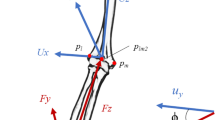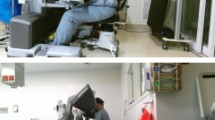Abstract
Purpose
Identifying the elbow flexion–extension (F–E) movement axis is important for placing a hinged elbow external fixator. An X-ray fluoroscopy-based method is widely used in clinical practice, exposing the patient and surgeons to high doses of radiation. Additionally, the accuracy and repeatability of the fluoroscopy-based method are very low and affected by subjective factors.
Methods
To solve this problem, an X-ray-free method based on kinematics analysis was proposed to identify the elbow F–E movement axis, and a navigation system was built to guide the placement of the elbow external fixator.
Results
Our X-ray-free navigation method is more repeatable than the current X-ray fluoroscopy method used clinically. Both our algorithm and the NIST (National Institute of Standards and Technology) algorithm showed high accuracy and repeatability to identify the axis.
Conclusions
The method proposed in this study is very promising to avoid a large dose of X-ray radiation and increases the repeatability and performance of identifying the elbow F–E movement axis for the placement of the hinged elbow external fixator.









Similar content being viewed by others
Abbreviations
- F–E:
-
Flexion–extension
- \(\hbox {X}_W \hbox {Y}_W \hbox {Z}_W \) :
-
Coordinate system of the positioning system
- \(\hbox {X}_H \hbox {Y}_H \hbox {Z}_H \) :
-
Coordinate system of the humerus tracker
- \(T_{H\rightarrow W} \) :
-
Space transformation from \(\hbox {X}_H \hbox {Y}_H \hbox {Z}_H \) to \(\hbox {X}_W \hbox {Y}_W \hbox {Z}_W \)
- \(P_W \) :
-
Point set of the position of the ulna tracker in reference to \(\hbox {X}_W \hbox {Y}_W \hbox {Z}_W \)
- \(P_H \) :
-
Point set of the position of the ulna tracker in reference to \(\hbox {X}_H \hbox {Y}_H \hbox {Z}_H \)
- \(P_{Hi} \) :
-
The \(i\hbox {th}\) point of dataset \(P_H \)
- \({P_{H}}^{\prime }\) :
-
Point set of the projection of \(P_H \) to plane \(\beta \)
- \({P_{Hi}}^{\prime }=[{P_{Hi}^x }~{P_{Hi}^y }~{P_{Hi}^z }{]}\) :
-
The \(i\hbox {th}\) point of dataset \(P_H ^{{\prime }}\)
- \({{{\varvec{n}}}}_r \) :
-
Orientation vector of the elbow flexion–extension axis
- \(\beta \) :
-
The plane on which \(P_H ^{{\prime }}\) distributes
- PC1:
-
The first principal component of \(P_H \)
- PC2:
-
The second principal component of \(P_H \)
- PC3:
-
The third principal component of \(P_H \)
- \(E[\cdot {]}\) :
-
Mathematical expectation
- \(\mathrm{Cov} \left( \cdot \right) \) :
-
Covariance matrix
- \({\varvec{\alpha }} _\mathrm{min} \) :
-
The eigenvector of the \(\mathrm{Cov}\left( {P_H } \right) \) smallest eigenvalue
- \(P_m =[{P_m^x }~ {P_m^y }~ {P_m^z }{]}\) :
-
The centroid of \(P_H \)
- \(P_a =[{P_a^x }~ {P_a^y }~{P_a^z }{]}\) :
-
The position (centre) of the elbow F–E axis
- N :
-
The number of points of dataset \(P_H \)
- S :
-
The degree of the simulated arc circle
- \({\upsigma }\) :
-
The standard deviation of the noise added to the simulated arc circle
- \(P_\mathrm{E} \) :
-
The enter-point of the axis pin in the model test
- \(P_\mathrm{O} \) :
-
The outpoint of the axis pin in the model test
- \(l^{r}\) :
-
The real axis of the simulated F–E movement
- \(l_j\,\left( {j=1,2,\ldots ,5} \right) \) :
-
The calculated axis of the \(j\hbox {th}\) F–E movement of the elbow model or specimen
- \(l^{m}\) :
-
The mean optimal axis of the five F–E movements of the elbow model or specimen
- \(C_j\,\left( {j=1,2,\ldots ,5} \right) \) :
-
The calculated position (centre) of the \(j\hbox {th}\) elbow model or specimen movement
- \(E_\mathrm{sa}\) :
-
The axis angle errors of the simulated kinematics data
- \(E_\mathrm{st}\) :
-
The axis position (centre) errors of the simulated kinematics data
- \(\mathrm{Ang} (A,B)\) :
-
The angle between line A and line B
- Dist (A, P):
-
The distance from point P to line A or Circle A
- \(E_\mathrm{t} \) :
-
The mean axis position (rotation centre) error in the model or specimen experiment
- \(E_\mathrm{a} \) :
-
The mean axis orientation error in the model or specimen experiment
- \(E_\mathrm{r} \) :
-
The distance from the kinematics data \(P_H \) to the circle fitted in the model or specimen experiment
- n :
-
The sample size of the statistical comparison
- T :
-
T is the duration of placing the axis pin under navigation
- T1:
-
The time of acquiring kinematics data
- T2:
-
The duration of placing the axis pin under navigation
- A1:
-
Our algorithm
- A2:
-
NIST algorithm
- ROM1:
-
Range of specimen F–E movement after fixator placement
- ROM2:
-
The maximal range of motion of the elbow after external fixator placement
- NIST:
-
National Institute of Standards and Technology
References
Reichel LM, Morales OA (2013) Gross anatomy of the elbow capsule: a cadaveric study. J Hand Surg 38(1):110–116
Maniscalco P, Pizzoli AL, Brivio LR, Caforio M (2014) Hinged external fixation for complex fracture-dislocation of the elbow in elderly people. Injury 45:S53–S57
Kulkarni GS, Kulkarni VS, Shyam AK, Kulkarni RM, Kulkarni MG, Nayak P (2010) Management of severe extra-articular contracture of the elbow by open arthrolysis and a monolateral hinged external fixator. Bone Jt J 92(1):92–97
Ruan H-J, Liu S, Fan C-Y, Liu J-J (2013) Open arthrolysis and hinged external fixation for posttraumatic ankylosed elbows. Arch Orthop Trauma Surg 133(2):179–185
Anakwe RE, Middleton SD, Jenkins PJ, McQueen MM (2011) Patient-reported outcomes after simple dislocation of the elbow. J Bone Joint Surg Am 93(13):1220–1226
Deland JT, Garg A, Walker PS (1987) Biomechanical basis for elbow hinge-distractor design. Clin Orthop Relat Res 215:303–312
London JT (1981) Kinematics of the elbow. J Bone Joint Surg Am 63(4):529–535
Ouyang Y, Liao Y, Liu Z, Fan C (2013) Hinged external fixator and open surgery for severe elbow stiffness with distal humeral nonunion. Orthopedics 36(2):e186–e192
Iordens GIT, Den Hartog D, Van Lieshout EMM, Tuinebreijer WE, De Haan J, Patka P, Verhofstad MHJ, Schep NWL, Collaborative DE (2015) Good functional recovery of complex elbow dislocations treated with hinged external fixation: a multicenter prospective study. Clin Orthop Relat Res ® 473(4):1451–1461
Tan V, Daluiski A, Capo J, Hotchkiss R (2005) Hinged elbow external fixators: indications and uses. J Am Acad Orthop Surg 13(8):503–514
Ring D, Bruinsma WE, Jupiter JB (2014) Complications of hinged external fixation compared with cross-pinning of the elbow for acute and subacute instability. Clin Orthop Relat Res ® 472(7):2044–2048
Cheung EV, O’Driscoll SW, Morrey BF (2008) Complications of hinged external fixators of the elbow. J Shoulder Elb Surg 17(3):447–453
Madey SM, Bottlang M, Steyers CM, Marsh JL, Brown TD (2000) Hinged external fixation of the elbow: optimal axis alignment to minimize motion resistance. J Orthop Trauma 14(1):41–47
Ericson A, Arndt A, Stark A, Wretenberg P, Lundberg A (2003) Variation in the position and orientation of the elbow flexion axis. J Bone Joint Surg Br 85(4):538–544
Wiggers JK, Streekstra GJ, Kloen P, Mader K, Goslings JC, Schep NWL (2014) Surgical accuracy in identifying the elbow rotation axis on fluoroscopic images. J Hand Surg 39(6):1141–1145
Egidy CC, Fufa D, Kendoff D, Daluiski A (2012) Hinged external fixator placement at the elbow: navigated versus conventional technique. Compu Aided Surg 17(6):294–299
Bigazzi P, Biondi M, Corvi A, Pfanner S, Checcucci G, Ceruso M (2015) A new autocentering hinged external fixator of the elbow: a device that stabilizes the elbow axis without use of the articular pin. J Shoulder Elbow Surg 24(8):1197–1205
Shakarji CM (1998) Least-squares fitting algorithms of the NIST algorithm testing system. J Res Natl Inst Stand Technol 103:633–641
Piazza SJ, Okita N, Cavanagh PR (2001) Accuracy of the functional method of hip joint center location: effects of limited motion and varied implementation. J Biomech 34(7):967–973
Gamage SSHU, Lasenby J (2002) New least squares solutions for estimating the average centre of rotation and the axis of rotation. J Biomech 35(1):87–93
Halvorsen K (2003) Bias compensated least squares estimate of the center of rotation. J Biomech 36(7):999–1008
Halvorsen K, Lesser M, Lundberg A (1999) A new method for estimating the axis of rotation and the center of rotation. J Biomech 32(11):1221–1227
Piazza SJ, Erdemir A, Okita N, Cavanagh PR (2004) Assessment of the functional method of hip joint center location subject to reduced range of hip motion. J Biomech 37(3):349–356
Woltring HJ, Huiskes R, De Lange A, Veldpaus FE (1985) Finite centroid and helical axis estimation from noisy landmark measurements in the study of human joint kinematics. J Biomech 18(5):379–389
Marin F, Mannel H, Claes L, Dürselen L (2003) Accurate determination of a joint rotation center based on the minimal amplitude point method. Comput Aided Surg 8(1):30–34
De Momi E, Lopomo N, Cerveri P, Zaffagnini S, Safran MR, Ferrigno G (2009) In-vitro experimental assessment of a new robust algorithm for hip joint centre estimation. J Biomech 42(8):989–995
Ehrig RM, Taylor WR, Duda GN, Heller MO (2007) A survey of formal methods for determining functional joint axes. J Biomech 40(10):2150–2157
Schwartz MH, Rozumalski A (2005) A new method for estimating joint parameters from motion data. J Biomech 38(1):107–116
Kainz H, Carty CP, Modenese L, Boyd RN, Lloyd DG (2015) Estimation of the hip joint centre in human motion analysis: a systematic review. Clin Biomech 30(4):319–329
Veeger HEJ, Yu B (1996) Orientation of axes in the elbow and forearm for biomechanical modelling. In: Proceedings of the 1996 Fifteenth Southern, 1996. IEEE, pp 377–380
Stokdijk M, Meskers CGM, Veeger HEJ, De Boer YA, Rozing PM (1999) Determination of the optimal elbow axis for evaluation of placement of prostheses. Clin Biomech 14(3):177–184
Woltring HJ, Cappozzo A, Berme P (1990) Data processing and error analysis. In: Biomechanics of human movement, chap 10, pp 203–237
Woltring HJ (1991) Definition and calculus of attitude angles, instantaneous helical axes and instantaneous centres of rotation from noisy position and attitude data. In: 1991
Berme N, Cappozzo A (1990) Biomechanics of human movement: applications in rehabilitation, sports and ergonomics. Bertec
Song J, Ding H, Han W, Wang J, Wang G (2016) A motion compensation method for bi-plane robot-assisted internal fixation surgery of a femur neck fracture. Proceed Inst Mech Eng Part H J Eng Med 230(10):942–948
Shlens J (2014) A tutorial on principal component analysis. arXiv preprint arXiv:1404.1100v1
Bro R, Smilde AK (2014) Principal component analysis. Anal Methods 6(9):2812–2831
Wiles AD, Thompson DG, Frantz DD (2004) Accuracy assessment and interpretation for optical tracking systems. In: 2004. International Society for Optics and Photonics, pp 421–432
Stokdijk M, Biegstraaten M, Ormel W, de Boer YA, Veeger HEJ, Rozing PM (2000) Determining the optimal flexion-extension axis of the elbow in vivo–a study of interobserver and intraobserver reliability. J Biomech 33(9):1139–1145
Acknowledgements
This work was supported by the China Major R and D Plan (No. 2016YFC0105800) and National Natural Science Foundation of China (61361160417, 81271735).
Author information
Authors and Affiliations
Corresponding author
Ethics declarations
Conflict of interest
The authors declare no conflict of interest.
Ethical standard
All experiments were approved by the Institutional Review Board of the hospital.
Informed consent
Informed consent was not needed.
Electronic supplementary material
Below is the link to the electronic supplementary material.
Rights and permissions
About this article
Cite this article
Song, J., Ding, H., Han, W. et al. An X-ray-free method to accurately identify the elbow flexion–extension axis for the placement of a hinged external fixator. Int J CARS 13, 375–387 (2018). https://doi.org/10.1007/s11548-017-1680-8
Received:
Accepted:
Published:
Issue Date:
DOI: https://doi.org/10.1007/s11548-017-1680-8




